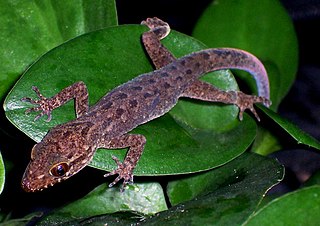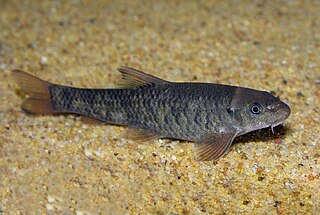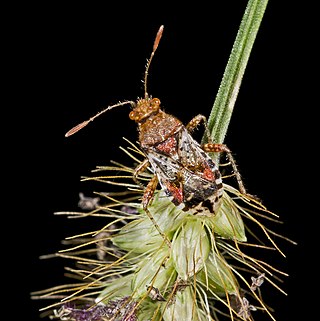
Cyprinidae is a family of freshwater fish commonly called the carp or minnow family, including the carps, the true minnows, and their relatives the barbs and barbels, among others. Cyprinidae is the largest and most diverse fish family, and the largest vertebrate animal family overall, with about 3,000 species; only 1,270 of these remain extant, divided into about 200 valid genera. Cyprinids range from about 12 mm (0.5 in) in size to the 3 m (9.8 ft) giant barb. By genus and species count, the family makes up more than two-thirds of the ostariophysian order Cypriniformes. The family name is derived from the Greek word kyprînos.

Ovenbirds or furnariids are a large family of small suboscine passerine birds found from Mexico and Central to southern South America. They form the family Furnariidae. This is a large family containing around 315 species and 70 genera. The ovenbird, which breeds in North America, is not a furnariid – rather it is a distantly related bird of the wood warbler family, Parulidae.

Cyrtodactylus is a diverse genus of Asian geckos, commonly known as bent-toed geckos, bow-fingered geckos, and forest geckos. The genus has 361 described species as of 2024, which makes it the largest of all gecko genera.

The red garra, also known as the doctor fish or nibble fish, is a species of cyprinid that is native to a wide range of freshwater habitats in subtropical parts of Western Asia. This small fish typically is up to about 14 centimeters in total length, but locally individuals can reach as much as 24 cm (9.5 in).

The boxelder bug, also called box bug, maple bug or, inaccurately, box beetle, is a species of true bug native to eastern North America. The western boxelder bug Boisea rubrolineata is a relative of this species and is native to western North America. Boxelder bugs are found primarily on boxelder trees, as well as on maple and ash trees.

Hypostomus is a genus of catfish in the family Loricariidae. They are native to tropical and subtropical South America. H. plecostomus is the popular freshwater aquarium fish formerly known as Plecostomus plecostomus. The taxonomic structure of the Loricariidae is still being expanded by scientists. Hypostomus is a highly species-rich and widely distributed catfish genus.

Stemmops is a genus of comb-footed spiders that was first described by Octavius Pickard-Cambridge in 1894.

Jadera haematoloma, the red-shouldered bug, goldenrain-tree bug or soapberry bug is a species of true bug that lives throughout the United States and south to northern South America. It feeds on seeds within the soapberry plant family, Sapindaceae, and is known to rapidly adapt to feeding on particular hosts. The species is often confused with boxelder bugs and lovebugs.
Polynoncus is a genus of beetles of the Family Trogidae. It contains the following species:

Rhopalidae, or scentless plant bugs, are a family of true bugs. In older literature, the family is sometimes called "Corizidae". They differ from the related coreids in lacking well-developed scent glands. They are usually light-colored and smaller than the coreids. Some are very similar to the orsilline lygaeids, but can be distinguished by the numerous veins in the membrane of the hemelytra. They live principally on weeds, but a few are arboreal. All are plant feeders. The type genus for the family is: Rhopalus. Currently 30 genera and over 240 species of rhopalids are known. The oldest fossil rhopalids described are from the Middle Jurassic of Inner Mongolia, discovered from the Haifanggou Formation. They are not considered economically important with a few species being pests of ornamental trees.
Austroleptis is a genus of snipe flies, and the sole genus in the family Austroleptidae; until 2010, it was placed in the family Rhagionidae. They are small to moderately sized flies of around 3 to 7.7 mm.

The Nemacheilidae, or stone loaches, are a family of cypriniform fishes that inhabit stream environments, mostly in Eurasia, with one genus, Afronemacheilus found in Africa. The family includes about 790 species.

Wanda Wesołowska is a Polish zoologist known for her work with jumping spiders. She has described more species of jumping spider than any contemporary writer, and is second only to Eugène Simon in the history of arachnology. Originally a student of ornithology, she developed an interest in jumping spiders while still a student at the Siedlce University of Natural Sciences and Humanities in the 1970s.

Aufeius is a genus of scentless plant bugs in the family Rhopalidae. There is one described species in Aufeius, A. impressicollis.
Erigomicronus is a genus of sheet weavers erected by A. V. Tanasevitch in 2018 for two east Asian species. In the following week, B. K. Seo published the new genus Collis for three Korean species. Further investigation revealed that all five belonged to the same genus, and preferences was given to the one published mere days before the other.
Cyrtodactylus kazirangaensis is a species of gecko. It is endemic to Assam, Northeast India, where it is only known from its type locality at the northern edge of the Mikir Hills. Its true range could extend into the Kaziranga National Park, to which its specific name refers to.
Cyrtodactylus montanus is a species of gecko. It is endemic to Jampui Hills in Northeast India.












